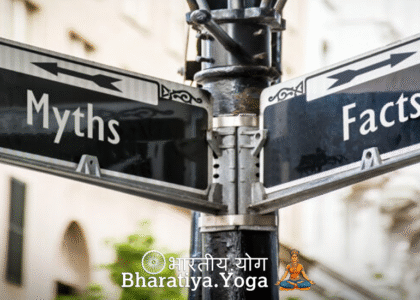Beyond the Mat: The Profound Connection Between What You Eat and How You Feel
You diligently practice your asanas, cultivate your breath through pranayama, and strive for stillness in meditation. But have you ever considered that the fuel you put into your body plays an equally vital role in deepening your yogic journey?
At Bharatiya.Yoga, we understand that authentic well-being extends far beyond the physical postures. It encompasses every aspect of your being, including what nourishes you. Just as a plant needs the right soil and sunlight to flourish, your body and mind require specific nourishment to truly blossom in your yoga and meditation practice.
Welcome to the fascinating intersection of nutrition and yoga – a powerful synergy rooted in ancient Indian wisdom, particularly Ayurveda, the sister science of Yoga.
The Yogic Perspective on Food: More Than Just Calories
In the yogic tradition, food is seen as Prana – the vital life force. It’s not just about macronutrients or micronutrients; it’s about the energy and qualities (gunas) that food imparts to your body and mind. According to Yoga and Ayurveda, foods are categorized into three main qualities:
- Sattvic (Pure, Harmonious): Foods that promote clarity, lightness, calm, and inner peace. They are fresh, wholesome, easily digestible, and naturally energizing without overstimulation. This is the cornerstone of a yogic diet.
- Rajasic (Stimulating, Active): Foods that are overly stimulating, creating restlessness, agitation, and aggression. While they might provide a burst of energy, it often comes with a subsequent crash and can disturb the mind.
- Tamasic (Dull, Inert): Foods that promote heaviness, lethargy, dullness, and negativity. They are often stale, processed, or difficult to digest.
Understanding these qualities is fundamental to making conscious dietary choices that support your yoga and meditation practice.
Sattvic Nutrition: Fueling Your Inner Radiance
A Sattvic diet is the ideal choice for anyone committed to a holistic yogic path. It nurtures the body without burdening it, calms the mind, and cultivates inner peace, making your meditation and asana practice more profound and effortless.
Key characteristics and examples of Sattvic foods include:
- Fresh Fruits: Seasonal, ripe fruits (apples, bananas, berries, mangoes, melons) are vibrant with prana, easily digestible, and cleansing.
- Fresh Vegetables: Most vegetables, especially leafy greens, root vegetables, and gourds, are Sattvic. Opt for organic and seasonal varieties.
- Whole Grains: Easily digestible grains like rice, oats, quinoa, and barley provide sustained energy.
- Legumes: Mung beans, lentils, and chickpeas provide plant-based protein without heaviness.
- Nuts & Seeds (in moderation): Almonds (soaked), walnuts, pumpkin seeds, sunflower seeds offer healthy fats and nutrients.
- Dairy (Lacto-Vegetarian Approach): Fresh milk, ghee (clarified butter), fresh yogurt, and paneer (fresh cheese) are considered Sattvic when consumed from healthy sources and in moderation.
- Healthy Oils: Ghee, coconut oil, olive oil.
- Mild Spices: Turmeric, cumin, coriander, ginger, fennel (used to aid digestion, not to overstimulate).
- Herbal Teas: Calming and cleansing.
- Pure Water: Hydration is paramount.
The Impact of Nutrition on Your Yoga & Meditation Practice:
- Enhanced Physical Agility & Stamina:
- Lighter Body: A diet rich in fresh, wholesome foods reduces sluggishness and enables greater ease and flexibility in asanas. You’ll find yourself flowing more freely and holding poses with greater stability.
- Sustained Energy: Sattvic foods release energy gradually, preventing blood sugar spikes and crashes, ensuring you have steady stamina for longer practices. This is crucial for working professionals fitting yoga into busy schedules.
- Calm & Focused Mind for Meditation:
- Reduced Mental Agitation: Rajasic foods (excessive caffeine, spicy foods, processed sugars) can create restlessness and distraction. Tamasic foods (heavy, stale, processed) can lead to lethargy and dullness. A Sattvic diet naturally calms the nervous system, making it easier to sit still, concentrate, and enter deeper states of meditation. This directly impacts stress reduction and mental clarity.
- Improved Concentration: When the digestive system is not overburdened, the mind is clearer and more capable of focus (Dharana), a vital step towards successful meditation (Dhyana).
- Deeper Breathwork (Pranayama):
- Clearer Energy Channels: A clean, light diet helps purify the body’s energy channels (nadis), allowing Prana to flow more freely. This enhances the effectiveness of pranayama techniques, leading to better breath control and increased vital energy.
- Emotional Balance & Well-being:
- Emotional Stability: Just as food impacts your physical and mental state, it also influences your emotions. A balanced, pure diet contributes to greater emotional stability, reducing irritability and promoting contentment (Santosha). This is key for work-life balance and general happiness.
Mindful Eating: The Yogic Approach to Consumption
Beyond what you eat, how you eat is equally important in yoga. Mindful eating is a practice in itself, transforming your meals into an act of self-care and reverence.
- Eat When Truly Hungry: Listen to your body’s signals, not just cravings or external cues.
- Eat in a Calm Environment: Avoid distractions like TV, phone, or work. Focus on the food.
- Chew Thoroughly: Aids digestion and allows your body to register fullness.
- Eat Until Satisfied, Not Stuffed: Leave about a quarter of your stomach empty to aid digestion.
- Express Gratitude: Acknowledge the nourishment and energy the food provides.
- Connect to Your Food: Pay attention to the colors, textures, aromas, and flavors.
By integrating mindful eating, you extend the principles of mindfulness from your yoga mat into every meal, enhancing digestion, absorption, and the overall energetic impact of your food.
Practical Tips for Integrating Yogic Nutrition into Your Daily Life:
- Start Small: Don’t overhaul your entire diet overnight. Begin by incorporating more fresh fruits and vegetables.
- Prioritize Fresh & Wholesome: Opt for whole, unprocessed foods over packaged and refined ones.
- Cook at Home: This gives you control over ingredients and promotes mindful preparation.
- Hydrate Adequately: Drink plenty of pure water throughout the day.
- Listen to Your Body: Pay attention to how different foods make you feel, both immediately and hours later. Your body is your best guide.
- Be Mindful of Seasonality: Eating seasonal, local produce aligns with Ayurvedic principles and maximizes freshness.
- Reduce Rajasic & Tamasic Foods: Gradually cut down on excessive caffeine, deep-fried foods, processed sugars, stale food, and heavy meats if they don’t serve your practice.
Fuel Your Journey with Bharatiya.Yoga
At Bharatiya.Yoga, we believe that conscious nutrition is an indispensable pillar of a truly holistic yogic life. Our platform offers more than just physical practices; we provide resources to guide you in every aspect of your well-being.
Through our expert-led content, including dedicated workshops on Ayurvedic nutrition and mindful eating, you’ll gain the knowledge and practical tools to optimize your diet, deepen your practice, and experience unparalleled levels of health, happiness, and harmony.
Ready to nourish your body, calm your mind, and elevate your spirit?
Explore our resources on nutrition and well-being, and discover how the right fuel can transform your entire being.
👉 Deepen Your Holistic Journey: Explore Our Nutrition & Wellness Programs at Bharatiya.Yoga!





